Download WordPress: The Essential Guide
If you're ready to download WordPress, this guide will walk you through all the things you need to know about how the WordPress download process works. Downloading WordPress is quick and easy, but you may have a few more questions about how to get your WordPress website up and running. Let's dive in!

If you’re ready to download WordPress, this guide will walk you through all the things you need to know about how the WordPress download process works.
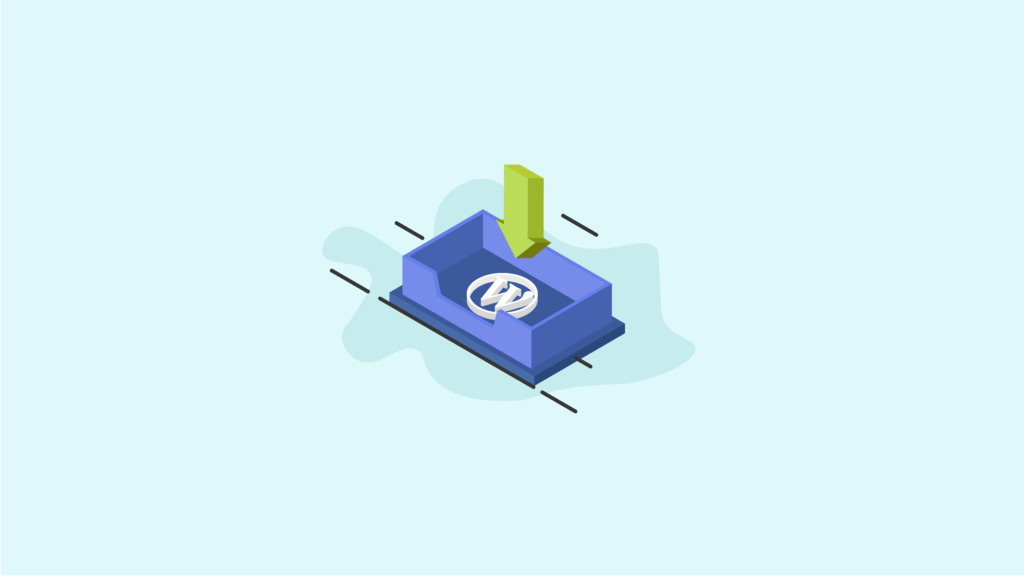
Downloading WordPress is quick and easy, but you may have a few more questions about how to get your WordPress website up and running. Let’s dive in!
In this article, we’ll be talking specifically about using WordPress.org as a content management system. This information does not necessarily apply to using the WordPress.com platform (we’ll cover more on that later).
Let’s look at how to download WordPress.
The WordPress Download Process Explained
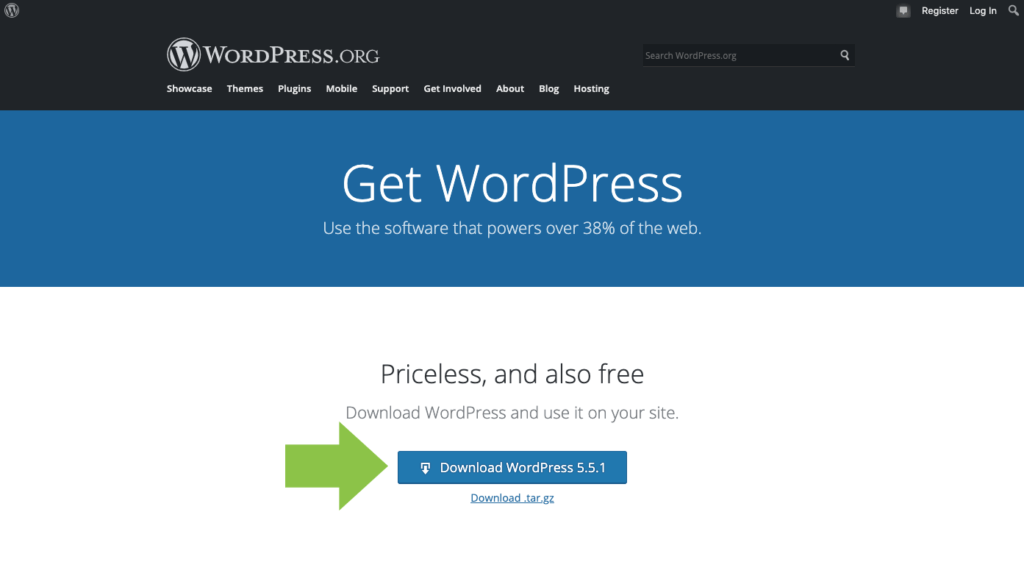
Standard use of the WordPress software involves downloading the WordPress core files together in the form of a zip file. You initially download the WordPress software in a zip file, directly to your computer.
After downloading the WordPress core zip file and properly installing it on a web server, you’ll have full access to all WordPress core functionalities for building and managing a new website.
Just remember the WordPress software doesn’t do much on its own. Before you can get started with WordPress, you’ll first need to:
- Purchase a domain and WordPress web hosting package
- Download the WordPress core software (which we’ll show you how to do below)
- Set up a WordPress database for your website
After these steps are completed, you can then:
- Install WordPress core, either on a web server or locally
- Install a WordPress theme to design your website
- Upload WordPress plugins to add more features and functionality, depending on your needs.
Can You Download WordPress for Free?
Unlike many of the content management systems or website builders, when you download WordPress, you won’t ever be asked for a credit card or PayPal payment.
This is because WordPress is open-source software. WordPress is freely shared, accessed, changed and otherwise used (in modified or unmodified form) by any individual.
WordPress is also licensed under the GNU GPL Public License, a software agreement that exists to “guarantee your freedom to share and change all versions of a program—to make sure it remains free software for all its users.”
So when you run a site on WordPress, the only things you’ll need to pay for are your domain name and website hosting. Additional charges for site design upgrades such as paid themes, paid plugins or developer assistance are completely up to you.
WordPress.com vs. WordPress.org
As you download WordPress, you might still be wondering what the difference is between WordPress.com vs. WordPress.org. To fully understand the differences, you should read our full article covering WordPress.com vs WordPress.org.
WordPress.com, on the other hand, is a platform for building websites or blogs. On WordPress.com, you don’t need any external hosting account or domain name (although you can upgrade to a paid domain). You simply go to WordPress.com, sign up for a free account and start building your site. You don’t have to download WordPress if you use WordPress.com.
WordPress.org, conversely, can be described as the famous open-source software that’s used as the operating system for millions of websites and blogs. As we mentioned before, the WordPress software is 100% free, but it’s almost useless unless you get a hosting account for the WordPress software to ride on.
Keep in mind that some WordPress hosts offer one-click WordPress installation options that allow you to completely skip over the download process. We’ll cover that in a bit.
How Do I Download WordPress?
To download WordPress, simply go to WordPress.org/download.
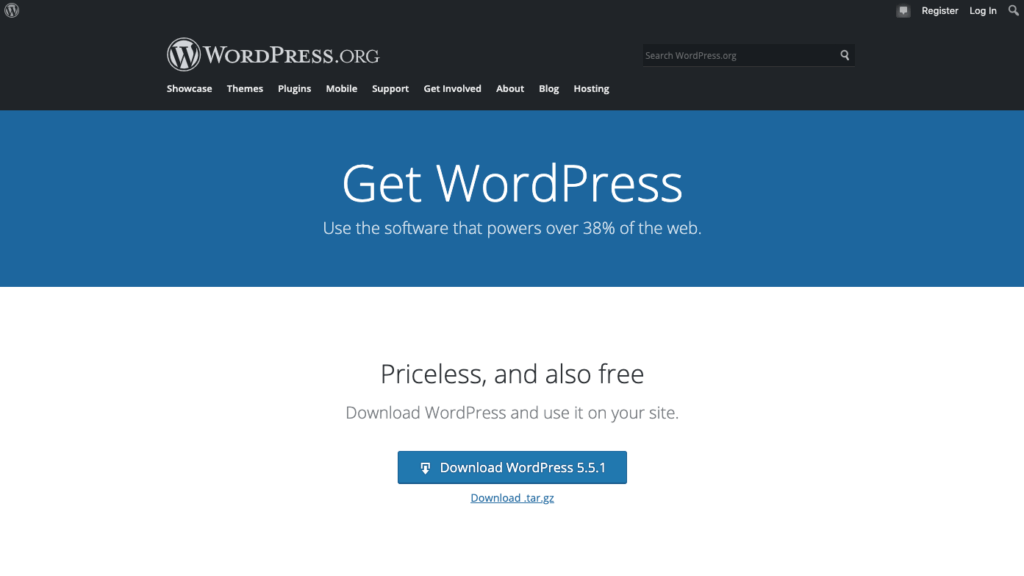
The official WordPress Download page is where you’ll find the WordPress core files available to download, as well as free themes and plugins to use on your website.
Click on the blue button to download the WordPress software, and the WordPress files will automatically begin downloading.

Once the download process is complete, you’ll notice a new zip file on your computer with the name “WordPress,” followed by the current version number.
What Files Are Contained in the WordPress Download?
After downloading WordPress, you may want to double-click on the WordPress folder to unzip the contents.
If you’re brand new to WordPress, the files in the WordPress folder may look confusing when you first look at them. However, with time, you’ll familiarize yourself with the WordPress core files and folders.
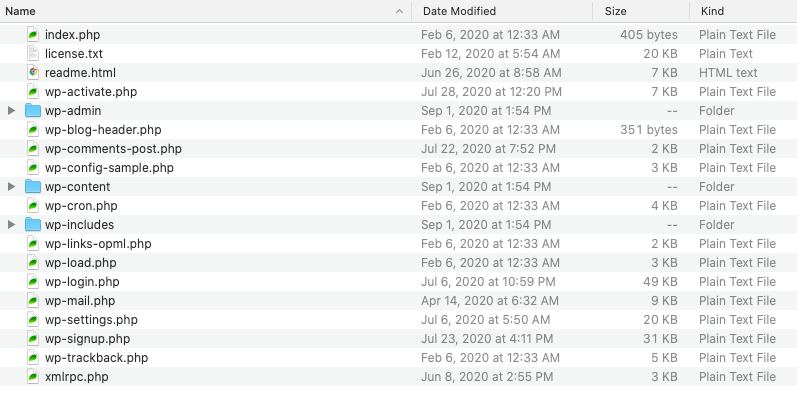
A few of the most important files and folders contained in the WordPress zip file you just downloaded include:
- wp-config.php – This file controls all the basic settings of your WordPress website, including your database connection information.
- functions.php – This file is one of the most important operating files of WordPress. Your theme will also have functions.php file.
- wp-content – This folder will contain your website’s plugins, themes and media uploads.
- wp-admin – This folder contains all the files that power the WordPress admin dashboard, or the backend of your website.
How to Install WordPress
After WordPress is downloaded, your next step is to install all the WordPress files to get your new website up and running.
You have two different options for where to install the WordPress files:
- Install WordPress on a live web server (for “live” websites)
- Install WordPress locally (for “development” websites)
The option you choose will depend on your setup, knowledge and preferences.
How to Install WordPress on a Web Server
Installing WordPress on a live site begins when you’re looking for a web host. As you’re shopping for a quality WordPress host, look for hosting plans that specialize in WordPress websites.
One-Click WordPress Installation
Some web hosts will offer a one-click WordPress installation as part of their hosting packages. With a one-click WordPress installation option, you’ll be able to skip over nearly all of the steps detailed in this article.
In fact, with One-Click WordPress Installation, you won’t even be required to download WordPress. That’ll all be taken care of for you within the one-click install option.
One-click WordPress installation is usually available from your web hosting control panel, such as cPanel. Login to your web hosting control panel (cPanel), using the information sent to you when you purchased your web hosting account.
From cPanel, you should see an icon that allows you to install the website CMS of your choice. In this case, we’ll use Softaculous. This application allows you to choose to install WordPress.

Just note that there are some inherent website security risks involved with one-click WordPress installation. While it takes a bit more work, the manual method of installing WordPress means you can customize (and secure) your website a bit more.
Get SolidWP tips direct in your inbox
Sign up
Get started with confidence — risk free, guaranteed
For the manual method of installing impress, you’ll want to follow these steps.
How to Install WordPress with sFTP
The first thing you’ll want to do is get an FTP/sFTP program. FileZilla is your best option for this.
Find your downloaded copy of the WordPress software and use FileZilla to upload it into your public directory, which will look as such: public_html.
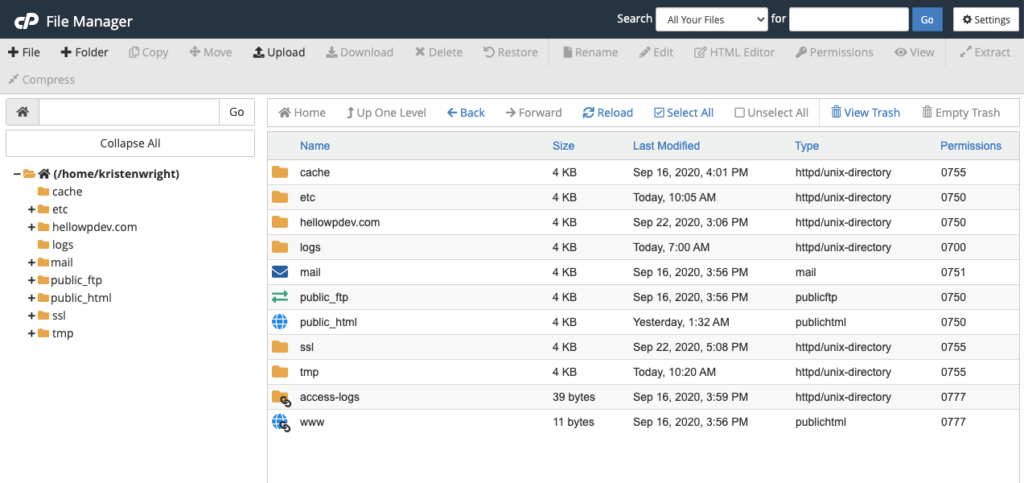
After the file transfer completes, you’ll see the WordPress files uploaded to your server.
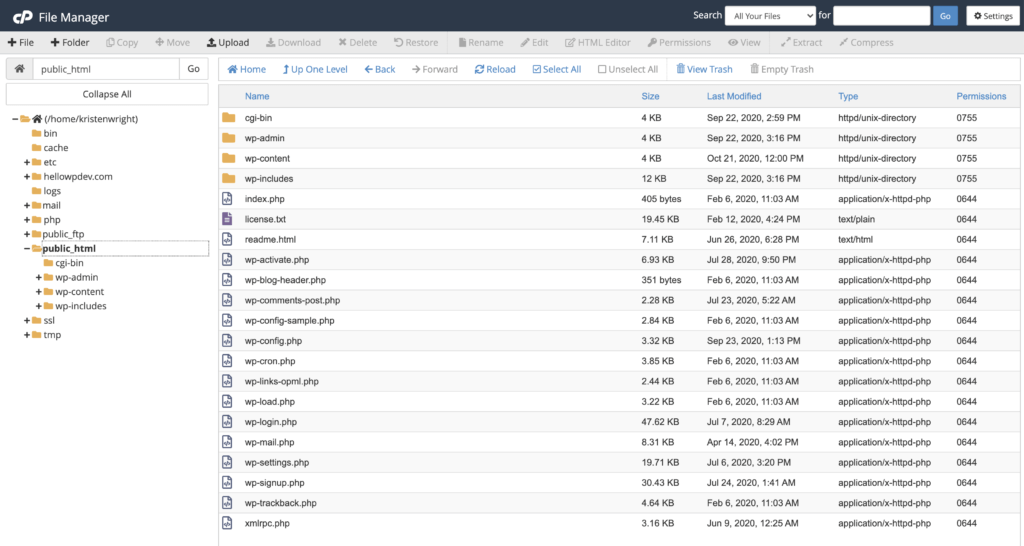
Next, go into your host’s cPanel and look for the button that says “MySQL Databases.” Depending on the host you use, the MySQL button can be found in a number of different locations. Poke around a little bit and you’ll find it.
After you click on it, you’ll be prompted to enter the name of your database. Once that’s done, click on “Create Database.”
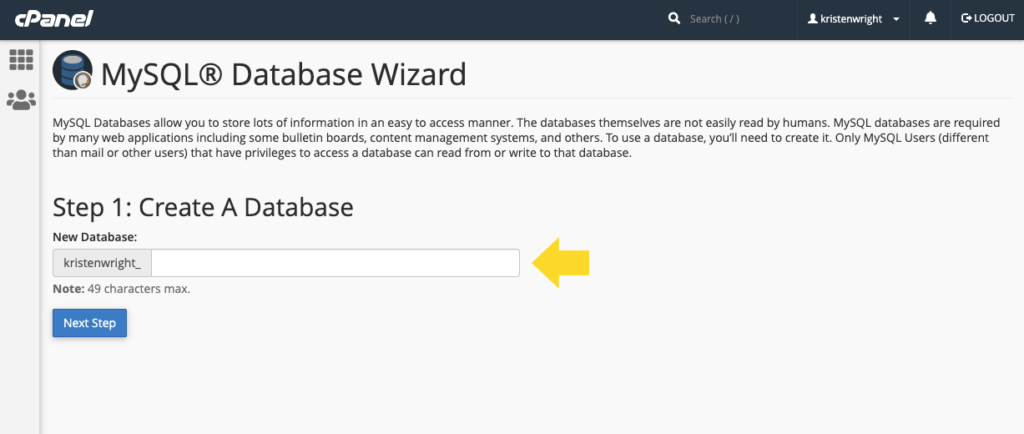
With your database now created, it will ask you to create a user for the MySQL account. Simply complete the information, including a new password, and create the new user. If the new user account is for someone other than yourself, make sure that you give the new user access to the database by giving them their login information.
On the next page, it’ll ask you about the privileges you wish to give to the new user. For an admin account, it’s always best to check all of these boxes.
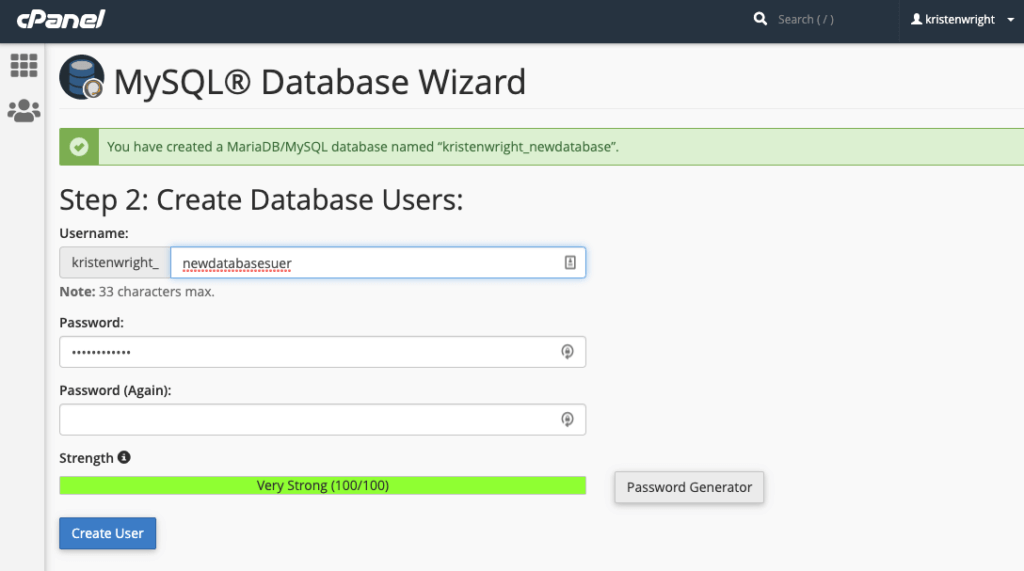
With your FTP transfer successful, you should now be able to navigate to your domain for installation completion. If the transfer has in fact succeeded, the first thing you’ll see is WordPress prompting you to choose what language your website will be displayed in.
Choose the desired language and continue.
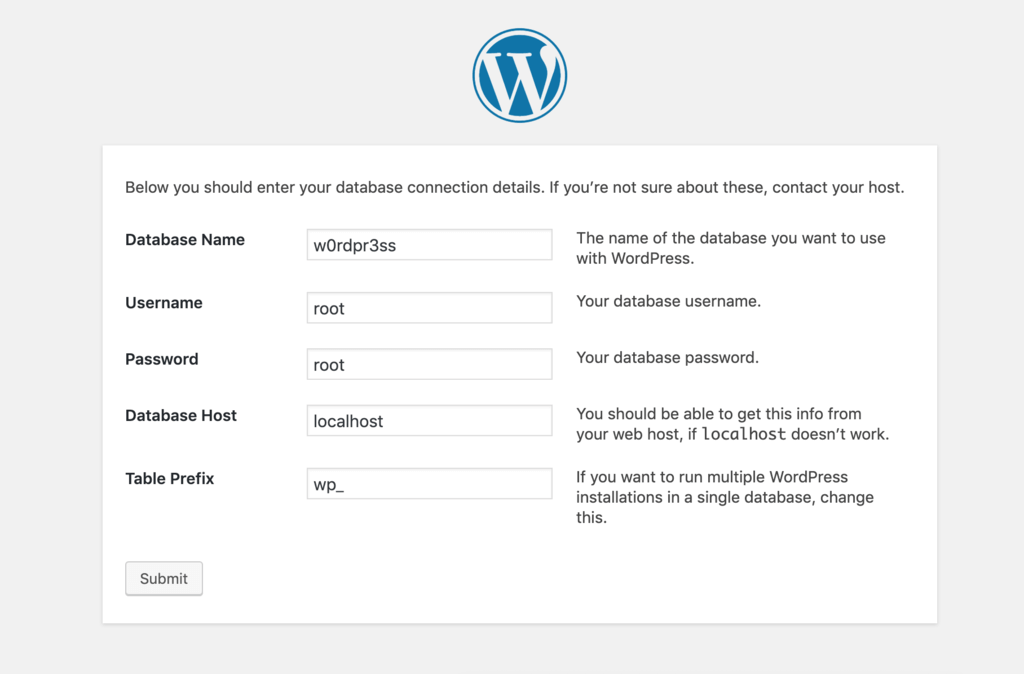
You’re now asked to input your database:
- Name
- Username
- Password
- Database Host
- Table Prefix
After you’re done with that, go ahead and click on the submit button.
Then, click “Run the Install,” and you’ll be prompted to enter your admin information for WordPress. This will be the site title, username, password and email that you entered previously.
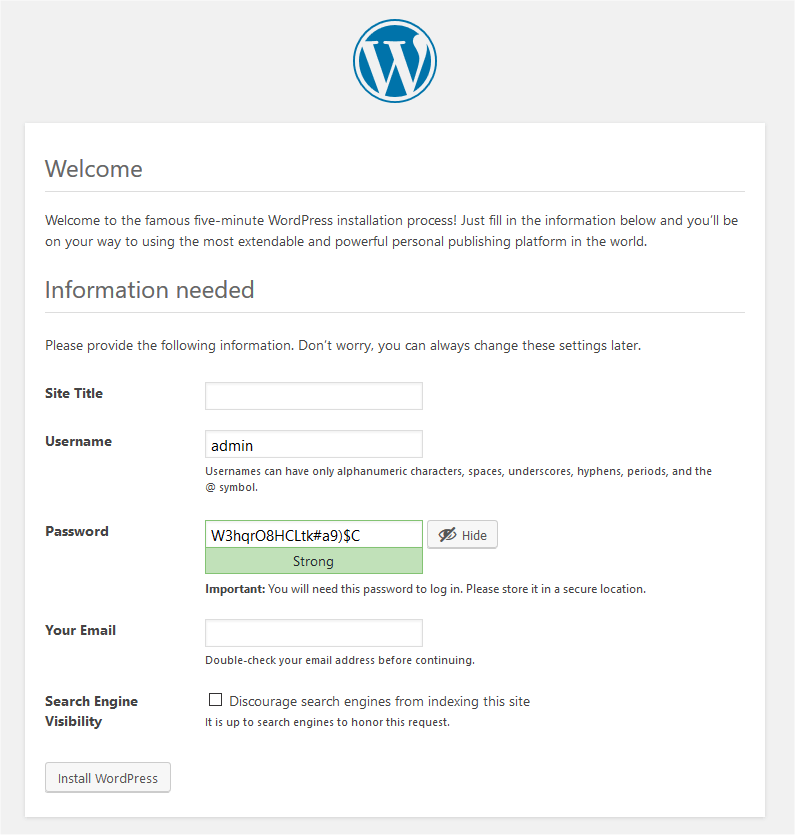
Lastly, it’s time to click on “Install” and let it do it’s thing. After it’s done, go ahead and login with the username and password you set up earlier.
Your manual installation of WordPress is now complete. Congratulations!
How Do I Install WordPress Locally (Windows or Mac)?
If you’re opposed to buying server space for your website testing and development environment (before you go live with your site), you can choose to use WordPress locally using a local server or host.
When you bypass the use of a live server by enabling a local host, you basically turn your computer into the server. This is a good option for users and developers that work remotely or don’t have a stable and steady internet connection.
Using a local host allows you to build a site with WordPress that’s completely independent of a connection to the internet.
What’s great about local WordPress sites is that you’re allowed multiple installations. This gives you multiple environments for testing and development.
The software required for hosting locally is also free, which makes it the perfect way to work with WordPress without poking around in a live website.
How to Install WordPress Locally for Windows
These steps will go over the local install and configuration of WordPress on your Windows machine.
1. Download WordPress and XAMPP
Before running your WordPress download, you first need to get a proper environment set up on your machine. You can do this by installing XAMPP from the Apache website to get a server set up.
When you go to download XAMPP, you’ll see several options that work with various versions of PHP. Choose the option that works best with the latest version of PHP.
Once your download is finished, go ahead and run it to install XAMPP on your Windows system.
After the installation, launch your control panel to view (and set) your status for MySQL and Apache.
You can’t install WordPress locally until you have both MySQL (database) and Apache (webserver) started.
2. Install WordPress
After your database and webservers are set up, download your application of WordPress from the official WordPress site, linked earlier in this article.
When the download is complete, move the zip file to the XAMPP directory under the /htdocs folder. Then, unzip the file before navigating to the directory.
This will only work if you have MySQL and Apache services running in your XAMPP control panel.
After this, go to your phpMyAdmin portal and create a database for your new site. Most likely, you can find the phpMyAdmin portal at this URL:
http://localhost:80/phpmyadmin/
It could be different, depending on your specific configuration.
After your database has been created, launch your WordPress installation by going to a unique URL that looks like this:
http://localhost:80/newsite/wp-admin/setup-config.php
Choose your desired language and click on “Continue.”
3. Add Database Credentials
The next screen will have you following steps to add credentials for your database to the wp-config.php file.
Use your code editor of choice to open the wp-config.php file. Then, define the database credentials as such:
// ** MySQL settings - You can get this info from your web host ** // /** The name of the database for WordPress */ define( 'DB_NAME', 'newsite' ); /** MySQL database username */ define( 'DB_USER', 'root' ); /** MySQL database password */ define( 'DB_PASSWORD', '' );
Then, save your file and go back to the WordPress installation wizard.
Here, simply enter your database name, username and password. You can also define a table prefix. For now, go ahead and keep the default value.
When you’re done, click on “Submit.”
The screen that follows will confirm a successful configuration. Click on “Run the installation” to start the process.
After this, simply provide specific information about your site. Set your username and password to login to the WordPress dashboard.
Once you’re done, click on the “Install WordPress” link. You’ll see a success message and a button to launch the login page for your dashboard.
You now have a working local copy of WordPress on your Windows machine.
How to Install WordPress Locally for Mac
If you prefer using a Mac over a Windows machine, you can also locally install WordPress on your Mac. As with Windows, you’ll need to set up your database and webserver before you install your application of WordPress.
The steps for Mac differ a bit than with Windows, but the overall process remains very similar.
1. Download MAMP
Before you do anything, download MAMP which will set up a database and webserver for your Mac WordPress installation.
All you need to do is go to the MAMP website to download the setup for your Mac OS.
Once your download has completed, install it by running the installation wizard. Note that you’ll probably be asked to install their Pro version. This isn’t mandatory. You can begin with the free version if you click on the grey folder.
Once the installation has finished, navigate to the MAMP controller and fire up the server.
After that’s running, click “Open Webstart page” and launch the phpMyAdmin portal.
2. Download WordPress
Download the software for core WordPress from the official site.
After you download your installation, unzip the file and place it inside the document root folder in MAMP.
Feel free to rename this folder to the name of your WordPress site.
3. Add Database Credentials
Then, create your database using phpMyAdmin, right through the control panel of MAMP. You’ll see that phpMyAdmin works the same in a Mac environment as it does in Windows.
Put in the name of your database, then head to the wp-config.php file to add credentials for the database.
You can now run the installation wizard for WordPress by going to your site-specific link that looks like this:
http://localhost/newsite
The remainder of the Mac installation steps will be the same as installing on Windows.
How to Download a WordPress Site
You may be wondering how to download a WordPress site. The good news is this is possible with the BackupBuddy plugin.
In order to download a WordPress website, you’ll need to make a copy of it. This is where you’ll need to know how to copy a WordPress site.
A copy of a WordPress website is essentially a backup of that website. You’ll need a complete backup of a WordPress website, a type of backup that contain all parts of the website, including the WordPress database, the WordPress core files, plugin files, theme files, and the WordPress media library.
Thankfully, a complete backup is one of the 5 types of WordPress backups that the BackupBuddy plugin can handle.
1. From your WordPress admin dashboard, upload and activate the BackupBuddy plugin.
2. Navigate to the BackupBuddy > Backups page. From here, run a Complete backup.
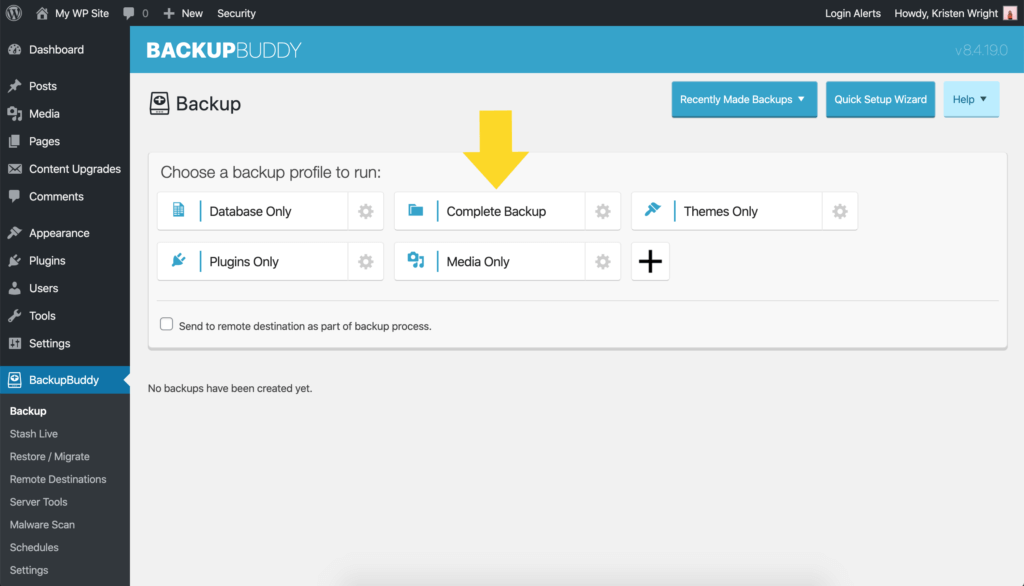
3. You can watch as the backup works to make a copy of all the files and the database.
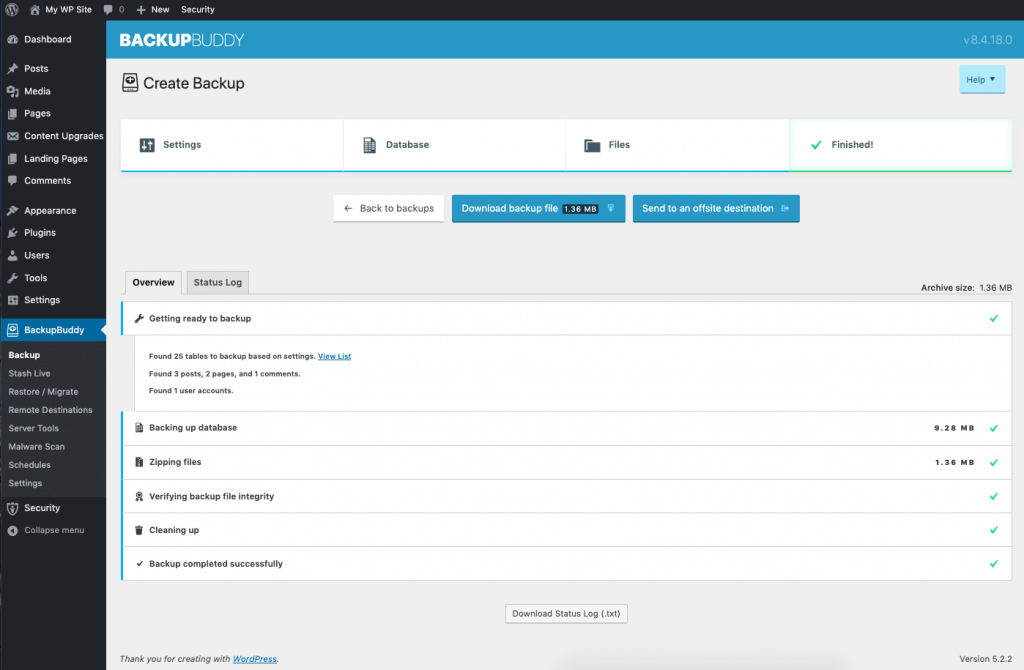
4. After the backup completes, you can click the Download backup file button to download the WordPress website.
Even if you don’t need to download a WordPress site, all website owners need to know it’s important to always have a backup of your website available in the case of a hacker breach or other technical catastrophe. Imagine watching your entire finished site disappear when you don’t have it fully backed up and restorable. What a nightmare!
This is exactly why you need a WordPress backup plugin like BackupBuddy. With it, you can download your entire finished WordPress site as a zip file, then restore it on your server in an instant, for any reason you need to.
What Is the Latest Version of WordPress?
You can find information on the latest version of WordPress located in two places: the WordPress releases page and on the WordPress.org/downloads page.
The WordPress version number allows you to compare the version number you have running on your WordPress website.
You can find the current WordPress version number of your WordPress site from your WordPress admin dashboard on the Home page in the At a Glance widget. You can also view it on the Updates page. The Updates page also includes important notices if you have pending updates for WordPress core, or any of your plugins or themes.
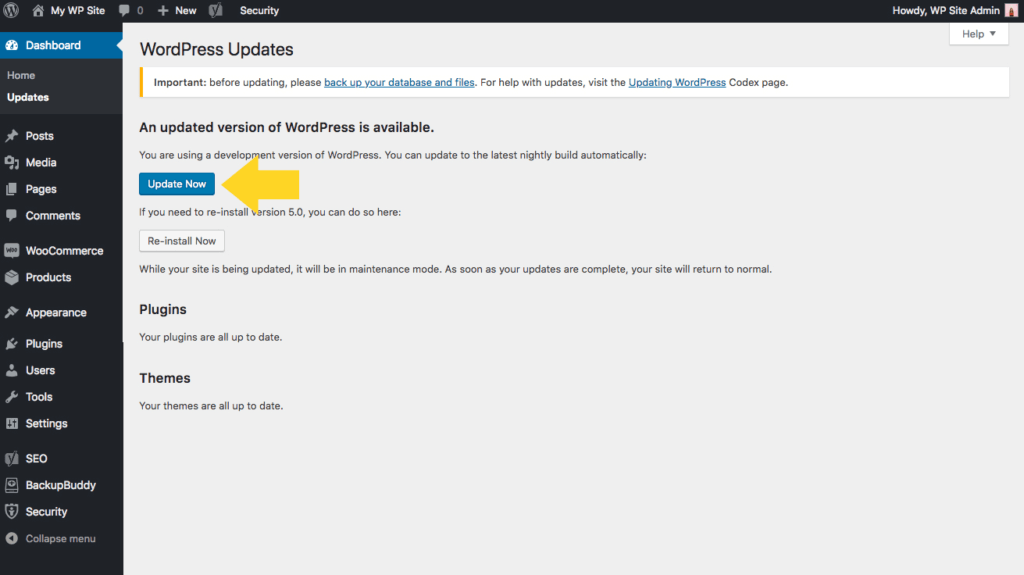
One of the most substantial recent upgrades to WordPress core came earlier in 2020, with the release of the Gutenberg WordPress Editor (also commonly referred to as the WordPress block editor). The Gutenberg Editor is a brand new page builder released in 2020 that was included in WordPress version 5.0 and forward.
The first version of WordPress, version 0.7, was released on May 27, 2003. In technology years, that sounds like many lifetimes ago. Since that time, major upgrades and re-toolings of the WordPress platform have been made by its community of developers.
Why Download WordPress?
Long gone are the days when the main purpose of a WordPress download was to serve only personal bloggers. In fact, WordPress has been the driving force for developing and managing websites of all kinds since its inception in 2003.
Because of its continued advancements and growth, WordPress now powers over 37% of all sites on the web. This statistic even includes sites that are custom-coded or who don’t use a CMS (content management system). In other words, WordPress currently powers well over one-third of the entire Internet.
And while that’s an impressive statistic, you’re probably more concerned with what WordPress can do as your site’s CMS. You can read more on why WordPress is such a great option for powering your website.
WordPress as a Content Management System (CMS)
A content management system is defined as a software program that facilitates the creation, organizing, editing and publishing of content.
If you’ve researched ways to build websites, no doubt you’ve seen that there are several CMS options. Why is WordPress the CMS you should download and use to create your site?
The WordPress CMS gives users complete control over how their websites look, function and react across all user devices.
It’s also known to be quite user-friendly, even for beginners.
Some popular sites that you probably frequent that utilize WordPress as their chosen CMS, include:
- BBC America
- Variety
- TechCrunch
- The New Yorker
- Bloomberg Professional
- Sony Music
- MTV News
- The Official Star Wars Blog
- Many more
If WordPress is the best CMS solution for these giants, could it also be the solution for your project? Before diving into the details of how to download this content management system, first let’s look at some powerful reasons why you should use WordPress as your CMS.
Access a Worldwide Community
WordPress is what’s known as open source software. Because of this, there are many experts and volunteers that are ready to assist you with questions as you begin your project.
But beyond this, there are already thousands of current and helpful WordPress tutorials, easily accessible online, that will walk you through solving nearly any problem or question you can think of within the WordPress platform.
Even better, you can take insightful WordPress training courses that will turn you from novice to expert within a few weeks.
With the seemingly countless forums, chat boards and online lessons currently available, you’ll be able to troubleshoot any issue or solve any problem without ever sitting on hold waiting for a customer service person to come online.
WordPress simply doesn’t work that way. It’s much better defined as a community of users.
WordPress Is Highly Versatile
You can use WordPress to create anything from a high-scale eCommerce site to a fully interactive online community. And yes, you can still use it to create a simple personal blog (we’ll touch on the differences between WordPress.com vs WordPress.org in a bit. Hint: WordPress.com is normally used for personal blogs).
It’s difficult to imagine any limits with this versatile CMS. Because of its extreme flexibility, you’re not confined to specific layouts, appearances or functionalities for your site. You’re completely free to create your site in any way you choose, by tapping into the huge myriad of site themes and plugins.
For those really interested in digging into site personalization, you can even customize your WordPress site using custom coding.
The versatility and freedom WordPress brings makes it the perfect solution for corporations, small businesses, personal bloggers and anyone else you can think of.
Endless Themes and Plugins for Customization
A theme on WordPress is defined as “a collection of templates and stylesheets used to define the appearance and display of a WordPress-powered website.”
With thousands upon thousands of free and paid themes available in the WordPress repository and throughout the web, you can find a customizable theme that will suit any design ideas.
Plugins are downloadable and installable software add-on tools that accomplish specific functions on your site. For example, you can use the WooCommerce plugin to turn your WordPress site into a full-featured eCommerce site.
Or, you can use a plugin such as PeepSo to create a stand-alone social media site that looks and functions almost exactly like Facebook or Twitter.
The WordPress plugin repository has nearly 58,000 plugins available for download. The additional number of available plugins scattered throughout the web are in the hundreds of thousands. The reality is that there is a WordPress plugin for almost anything you can think of.
For the sake of site security, a WordPress security plugin like iThemes Security Pro should be the first plugin you download and install after setting up WordPress (we’re almost there).
By combining the power of themes and plugins, you can turn your WordPress-powered site into nearly anything you can imagine.
WordPress Integrates With the Best Marketing Tools
You want a CMS that seamlessly integrates with all of the most popular marketing tools. WordPress does just that, by integrating with:
- Hootsuite
- Constant Contact
- CoSchedule
- Disqus
- Buffer
- Google Analytics
- LinkPatrol
This is by no means an extensive list.
Choose the Host and Domain That You Want
Since WordPress is a completely open and free CMS, WordPress gives you the freedom to research and buy any hosting and domain name service you want to use.
On the other hand, if you choose one of the competing website builder CMS options to build your site, you’ll be pigeonholed into using their hosting services.
This could cause a wide array of problems with your site vulnerability and security because you’ll have no personal control over most of the security configurations.
Wrapping Up: Download WordPress and Get Started Today
We hope we’ve answered all your questions about how to download WordPress. Once you figure out the WordPress download process and install WordPress, you’re on your way to building the website of your dreams!
Get SolidWP tips direct in your inbox
Sign up
Get started with confidence — risk free, guaranteed
Have more questions about getting started with WordPress? Let us know in the comments below.
Sign up now — Get SolidWP updates and valuable content straight to your inbox
Sign up
Get started with confidence — risk free, guaranteed